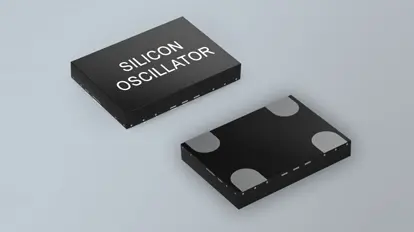The time requirements in modern metering applications have become much stricter in recent years. In modern metering applications, a time offset of 1 hour after 7 years is often required. It should also be possible to maintain this value over the operating temperature range of the application. 1 hour max. after 7 years corresponds to a frequency tolerance of ±16 ppm absolute at 32,768 kHz. These specifications can no longer be met with normal 32.768 kHz oscillating crystals.
On the one hand, because a 32.768 kHz is only available with a frequency tolerance at +25°C of ±10ppm, on the other hand, the temperature stability is a good -180ppm over the temperature range of -40/+85°C. The ageing of approx. ±30 ppm after 10 years must not be forgotten in the accuracy calculation. In the worst case, a 32.768 kHz crystal has a maximum frequency stability of +40/-220ppm (including adjustment at +25°C, temperature stability and ageing after 10 years). A systematic frequency offset caused by the internal capacitances of the oscillator stage of the IC to be clocked and stray capacitances must be compensated for by external circuit capacitances. If a layout without external circuit capacitances is selected for the 32.768 kHz crystal, this is very dangerous because the accuracy of the 32.768 kHz crystal cannot be corrected or adapted to suddenly changing PCB ratios during series production. The cutting angle for the 32.768 kHz crystal was actually developed for optimum accuracy in a wristwatch and not for most applications in which it is used today.
[caption id="attachment_62" align="alignleft" width="300"] Figure 1: Temperature behaviour of a commercially available 32.768 kHz quartz[/caption]
As the clocking specialist, we offer the ultra low power 32.768 kHz oscillator of the ULPPO series in order to meet the most precise time specifications. This oscillator can be operated with any voltage in a VDD range of 1.5 - 3.63 VDC. The current consumption is specified at 0.99 µA. The temperature stability of the ULPPO is ±5ppm over the temperature range of -40/+85°C. The frequency stability (delivery accuracy plus temperature stability) is ±10ppm and the ageing after 20 years is ±2ppm. This means that the maximum overall stability of the ULPPO is ±12 ppm including ageing after 10 years. These are industry-best parameters.
No external circuit capacitance is required for wiring the ultra-small housing (housing area 1.2mm2). The input stage of the IC built into the ULPPO filters the supply voltage itself. Compared to a quartz crystal, the use of the ULPPO saves an enormous amount of space on the circuit board, so that the packing density can be increased and smaller circuit boards can be developed. The current consumption of the ULPPO can also be reduced by adjusting the amplitude.
When calculating the space on the board for a crystal, the two external circuit capacitances must also be taken into account. Even the smallest 32.768 kHz crystal always requires more space on the PCB with the two external circuit capacitances than the ULPPO.
In addition, very small 32,768 kHz crystals have very high resistances, which often can no longer be safely driven by the oscillator stages to be clocked, as the oscillator stages of the ICs or RTCsto be clocked also have very large tolerances. This can lead to sudden oscillation problems in the field, which can be avoided with the ULPPO, so that safe operation of the application with the ULPPO is possible under all circumstances.
An oscillator stage requires a lot of energy to keep a 32.768 kHz crystal oscillating. Normally, the input stage of an MCU can be connected directly to the LVCMOS signal of the ULPPO (usually Xin). The MCU's input stage can thus be switched off (bypass function) so that the energy saved can be used in the calculation of the meter's system power consumption. In addition, several ICs can be clocked simultaneously with one ULPPO. Due to the very high accuracy of the ULPPO, fewer time synchronisations need to be carried out, which also saves system current.
Of course, the ULPPO can be used in all applications that require a miniaturised ultra low power 32.768 kHz oscillator, such as smartphones, tablets, GPS, fitness watches, health and wellness applications, wireless keyboards, time measurement, timing applications, wearables, IoT, home automation, etc. Due to the high accuracy of the 32.768 kHz oscillator, the standby time or even the hybernation time can be significantly extended in hypernation technology applications, so that a lot of system power can be saved due to the significantly lower battery-intensive synchronisation cycles, making the 32.768 kHz oscillator the better choice than a 32.768 kHz quartz crystal. There are various precision versions of the ultra low power 32.768 kHz oscillators - see also the ULPO-RB1 and -RB2 series.
Our highly experienced specialists can provide you with comprehensive design-in services to help you design-in this highly innovative component quickly and accurately.
Further information is available at:
Ultra Low Power 32.768 kHz Oscillators
or
SMD Silicon Oscillators ULPO-RB1 & ULPO-RB2
Technical questions:
Phone: 0 81 91 / 30 53 95
E-mail: info(at)petermann-technik.de

